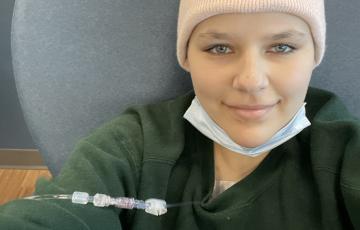Search Results

Christina
As a Greek Latina indie author, I found it empowering to share my fight with lymphoma through social media and with my current writing. Many have told me that it’s inspiring, and I hope that leads to more attention and support for those fighting blood cancers like lymphoma.

Jakob
I was diagnosed at two and a half years old in December 2003 at Valley Children’s Hospital. Some early symptoms that I had were paleness, unexplained fevers, and extreme fatigue. My babysitter noticed my naps were getting longer and longer as the days passed, and I was taken to my pediatrician because of the previously mentioned symptoms. I was diagnosed with pre-B-cell acute lymphoblastic leukemia (pre-B ALL). My length of treatment lasted three years and two months. I had oral, intramuscular, intrathecal, and IV chemotherapy over the course of the entire treatment.

Tiffany
I was first diagnosed in July 2015. The doctors in Joplin kept saying I had strep (which I did, at first) and it never got better. Appointments after appointments and I kept getting this. Despite the several medicines they had me on, I was still not feeling good. Nothing helped. Finally my friend forced me to go back to the hospital, where I had been four days later, and I was FINALLY diagnosed with acute myeloid leukemia (AML). Unfortunately, they did not have any doctors to treat it there.

Amanda
The word “warrior” seems too tame to describe Amanda Monteiro, a volunteer with The Leukemia and Lymphoma Society (LLS). She’s fueled by her desire to prevent another child from being diagnosed, another parent from having to say goodbye.

Judy
I was diagnosed with acute myelogenous leukemia (AML) on April 6, 1987, just four months after my 30th birthday.
My beautiful daughter had turned three in February. I loved being a mom, and a teacher. I was extremely active as many young parents are and was looking forward to spending more time outside "playing" as the weather improved in the great Canadian north. Life was good.

Cynthia
Cynthia was on a family vacation in 2015 when she began experiencing back pain so severe that she had to be in a wheelchair for the rest of the trip. When she returned home, Cynthia went to see her doctor who referred her to an oncologist. After several tests, Cynthia was diagnosed with multiple myeloma. She was devastated. Chemotherapy and radiation soon followed, along with horrible side effects, sleepless nights and countless blood transfusions. But Cynthia was not going to let cancer defeat her.

AnnaKate
In my junior year of college, I felt so sick that I would sleep through online classes, throwing up every couple of days. I thought I was just stressed and not sleeping enough at night. However, a month later, a relentless cough took over. It was nonstop ― cough after cough and nap after nap.

Donna
The cancer diagnosis was devastating, and the loss was more than anyone should have to bear. We lost our wonderful son, brother, fiance & friend Larry, on August 15th. He was 30 years and 18 days old. He had his whole future ahead of him with his soul mate, Vicki. Together, they were planning a wedding for seven weeks away, making plans for children and looking forward to a long life. He never made it down the aisle, never got to raise those babies and was taken from this earth way too soon. Larry was a bright light in our lives and is missed every second of every day.

Bob
I thought I was super healthy.
It was October 2017, and I had just run a half marathon a few days before. I went to get my blood tested to see if I still was eligible to donate a kidney to a friend who needed one. Four years earlier, I had gone through all the testing and was approved to be a donor for her, but her kidney function had improved enough that she didn't need a transplant right then. By late summer 2017, her condition had deteriorated, so I went back in to restart the process.
Autologous Stem Cell Transplantation
In autologous stem cell transplantation, the procedure uses the patient’s own stem cells for the transplant. The stem cells are collected from the patient in advance and are frozen. After the patient undergoes high doses of chemotherapy, either with or without radiation therapy, the stem cells are then returned to the body. This type of transplant is often used to treat blood cancers such as Hodgkin lymphoma, non-Hodgkin lymphoma and myeloma.
Legal and Financial
Advance DirectivesAdvance directives are a patient's instructions about future medical care in case he or she can no longer speak for himself or herself. Ideally, an advance directive should be in place before a person becomes ill or before a crisis.
#TILTCANCER - Start Your Charity Stream Today
#TiltCancer is The Leukemia & Lymphoma Society’s gaming & esports program. Join us and our community of content creators by creating a Livestream fundraiser, sign up for our video game fundraising events or become a #TiltCancer ambassador.
Blood Tests
When your doctor orders a blood test, he or she chooses from a list of chemical studies to be performed in a laboratory on your blood sample. These lab tests can provide important clues about what's going on inside your body.
If your doctor suspects you may have cancer, he or she may test your blood to:
Side Effects
Cancer therapy for non-Hodgkin lymphoma (NHL) can sometimes produce side effects. For most patients, treatment side effects are temporary and go away once therapy ends. For other patients, side effects can be more severe, sometimes requiring hospitalization. Some patients never have side effects.
Before you undergo treatment, talk with your doctor about potential side effects. In recent years, new drugs and other therapies have increased the ability to control side effects.
Treatment
In general, the goal of treatment is to destroy as many lymphoma cells as possible and to induce a complete remission. Complete remission means that all evidence of disease is eliminated. Patients who go into remission are sometimes cured of their disease. Treatment can also keep non-Hodgkin lymphoma (NHL) in check for many years, even though imaging or other studies show remaining sites of disease. This situation may be referred to as a “partial remission.”
Diagnosis
Having the correct diagnosis is important for getting the right treatment. Hodgkin lymphoma (HL) may be difficult to diagnosis. You may want to get a second medical opinion by an experienced hematopathologist before you begin treatment. A hematopathologist is a specialist who studies blood and bone marrow cells and other tissues to help diagnose diseases of the blood, bone marrow and lymph system.
Diagnosis
An accurate diagnosis is one of the most important aspects of a person’s care. Obtaining a precise diagnosis will help the doctor
- Determine the MDS subtype
- Estimate how the disease will progress
- Determine the most appropriate treatment
Since MDS can be a difficult disease to diagnose, you may want to get a second medical opinion by an experienced hematopathologist before you begin treatment.
Chemotherapy and Drug Therapy
There are many different types of drugs used in the treatment of MDS.
Lower-Risk MDSImmunosuppressive Therapy. Drugs that suppress certain parts of the immune system can help some patients with lower-risk MDS. In some types of MDS, lymphocytes, a type of white blood cell, may attack the bone marrow, causing it to stop making enough healthy blood cells. Immunosuppressive therapy lowers the body’s immune response to allow bone marrow stem cells to grow and make new blood cells. The main immunosuppressive therapy drugs used to treat MDS are:
Chemotherapy
ChemotherapyChemotherapy is the use of potent drugs or chemicals, often in combinations or intervals, to kill or damage cancer cells in the body. Chemotherapy drugs are often called anticancer agents. The drugs must be toxic enough to kill leukemic cells, which is why chemotherapy can be hard on your body; the drugs' toxicity can harm your healthy cells as well. However, successful chemotherapy depends on the fact that cancerous cells are more sensitive to the chemicals in the drug than normal cells are.
Allogeneic Stem Cell Transplantation
Allogeneic stem cell transplantation involves the use of stem cells from someone other than the patient. The donated stem cells can come from either a person related or not related to the patient.
Mental Health
The term “mental health” includes your emotional and psychological well-being. Your mental health guides how you handle stress, manage relationships and make decisions. Mental health, like physical health, is important to your overall well-being.
Emotions like sadness, anger or stress are normal and healthy responses to difficult life events, such as a cancer diagnosis. However, sometimes persistent feelings of sadness, stress or anxiety can be caused by a mental health disorder. Don't ignore any of these feelings. Talk to your healthcare team about how you are feeling.

Whitney
I am delighted to be a new member of the Clinical Trial Support Center team at The Leukemia & Lymphoma Society (LLS)! After eight years as a clinical nurse, charge nurse, and assistant nurse manager at various oncology hospitals across the country, I am honored to now work with blood cancer patients as a Spanish-speaking, CTSC nurse navigator.

Grace
On February 6, 2023, I was diagnosed with stage 3 Hodgkin lymphoma (HL). However, my story starts months before that. I was attending my sophomore year of college at my university when I started experiencing symptoms I did not understand or put together. I started experiencing extreme exhaustion, I was dropping weight very fast, and I was always lightheaded. I decided to come home only three weeks into my spring semester because I couldn’t keep up my course load with how bad I was feeling.
